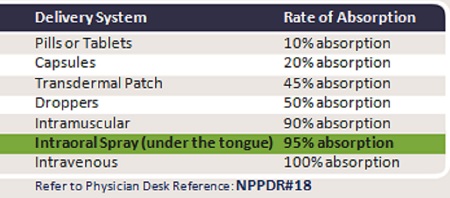Don’t waste your hard earned cash on the wrong type of health supplements. Here are 5 key points to consider before you buy any health supplement.
1. Absorption is Everything
A health supplement in liquid form that is consumed by spraying under the tongue is known as intraoral delivery.
In certain contexts, it may be referred to as sublingual. Intraoral is a viable way to take your health supplements as it offers an absorption rate of up to 95% of its nutrients compared to only a 10% to 20% absorption rate that pills and capsules provide. The sub-mucosal membrane that sits under our tongue enables nutrients taken intraorally to get directly into the bloodstream, straight away. You are therefore not wasting 80% to 90% of the nutrients as you do with pills and capsules.
Intraoral (apart from intravenous) provides the most concentrated source of nutrient delivery. See the graph below that illustrates absorption rate percentages for various applications.
Many pills and capsules when taken orally are quickly digested and metabolized in the intestines and liver, resulting in less than 5 percent of the oral dose in pill and capsule form remaining in the blood plasma. This metabolic process is known as the “first pass effect,” and results in the compounds being eliminated from the digestive and urinary system right after ingestion. Even if larger dosages of ingredients are consumed in pill form or a certain type of capsule coating is used (i.e. vegetable capsule), in almost all cases its concentration levels inside the blood still fail to reach the required levels necessary for effective nutritional value and most ingredients within the pill don’t even reach required levels for laboratory testing conditions. Intraoral delivery avoids the “first pass effect” issue.
This study found resveratrol administered by intraoral delivery is 250 times more effective than when taken in pill form.
2. Always Check The Label
Have you ever come across a health supplement that states the ingredients only in IUs (International Units) or Mcgs (micrograms)? Like nanograms (ngs) these measurements can equate to zilch. It is crucial you understand what these measurements equate too before you buy your health supplements.
Example 1. Converting IUs into Mgs
1a) 1 mcg Vitamin D3 (cholecalciferol) = 40 IU. Don’t mistake mcgs for mgs.
They are totally different measurements, and many people often don’t see the small “c” within mcgs, especially as supplement facts are often displayed in small text on the label.
1b) Let´s say you have 300 IU of Vitamin D: 300 / 40 = 7.5 mcg Vitamin D.
Then you would have to convert 7.5 mcg to mg: 7.5 / 1000 = 0.0075mg Vitamin D (less than 1mg).
1c) Another example, 5000 IUs of Vitamin D becomes 0.125mg of Vitamin D.
Example 2. Ng, MCG, MG and G Conversation Rates
5000mcg = 5mg
1000 nanograms (ng) = 1 microgram (mcg)
1000 micrograms (mcg) = 1 milligram (mg)
1000 milligrams (mg) = 1 gram (g)
It is recommended you buy health supplements that state the ingredients in milligrams (mgs) or grams. If IUs, Mcgs or Ngs are noted, ensure you do the math. Here are a couple of conversion tables to help you.
http://www.thecalculatorsite.com/conversions/common/mcg-to-mg.php
http://www.etoolsage.com/converter/IU_Converter.asp
3. Beware of Proprietary Blends
When a proprietary blend of ingredients is shown on the supplement label and no percentages of purity shown for each ingredient, this generally means a number of poor, low grade ingredients have been mixed together with practically no purity or nutritional value whatsoever.
Always look for standalone ingredients to be noted separately on a supplement label with the percentage of purity noted against each ingredient.
4. Beware of Certain Fillers, Binders and Artificial Sweeteners
Fillers, binders and artificial sweeteners will generally be noted under the “other” section at the bottom of the supplement fact panel. Sometimes they are noted as “inactive” ingredients. Most of these substances are not good for you. They are mostly used to bind ingredients together, fill and/or lubricate capsules, pills and tablets and are often used only to aid consumption and/or accelerate manufacturing processes.
Fillers and binders are not so common in liquid supplements because they are not required, as per the points below. Binders are mostly used to bind or hold ingredients together. They are typically a sugar derivative and include: lactose, sucrose, microcrystalline cellulose, sorbitol, propylene glycol, xylitol to name a few.
Sweeteners such as corn, sucralose (or splenda) should be avoided. In 2013 Splenda (sucralose) was downgraded from “safe” to “caution” after an Italian animal study linked sucralose to a higher risk of developing leukemia.
Magnesium stearate is used as a lubricant. It is formed by adding a magnesium ion to stearic acid. It is mostly used in vitamins to avoid them sticking to one another or the equipment when they are manufactured. Research to date shows the stearic acid suppresses T cells (your natural killer cells) that are a key component of a healthy immune system. Avoid hydrogenated oils. These have been found to encourage heart problems and upset blood sugar regulation.
The bottom line is you don’t want fillers, binders and artificial sweeteners in your health supplements.
5. Intraoral Spray Supplements Provide Huge Advantages
Whenever possible buy your quality health supplements in liquid form (preferably for administration via intraoral spray or in dropper form).
Remember to still check the points above. A wide range of quality liquid health supplements are now available.
Until now, buccal and intraoral spray delivery had been best advised for smaller particle molecules, therefore most vitamins and minerals ideally suit this form of administration. However, more recent science shows a great deal of biological compounds, nutraceuticals and drugs can be effectively administered in intraoral format. This is also a much more cost effective method of administration as a lower dosage of ingredient is required due to this being such a concentrated source of delivery.
The intraoral route of administration has recently been investigated for insulin and heparin. [Reference: International Journal of Pharmacy and Pharmaceutical Science Research – ISSN: 2249-0337 – February 2013 and Life Enhancement Magazine].
Key Advantages of intraoral delivery
- Increased bioavailability
- Higher plasma levels
- Rapid absorption and onset of actions
- Avoids pre-systemic elimination in the GI tract
- Avoids first-pass effect of the liver
- Avoids exposure to a hostile GI environment
- Ability to swallow is not required
From the Stem Cell Worx Team
Excellence in Nutritional Supplementation
(Copyright ©2014-2015 Stem Cell Worx. All Rights Reserved.)
Tags: best health supplements, effective absorption, health supplement tips







